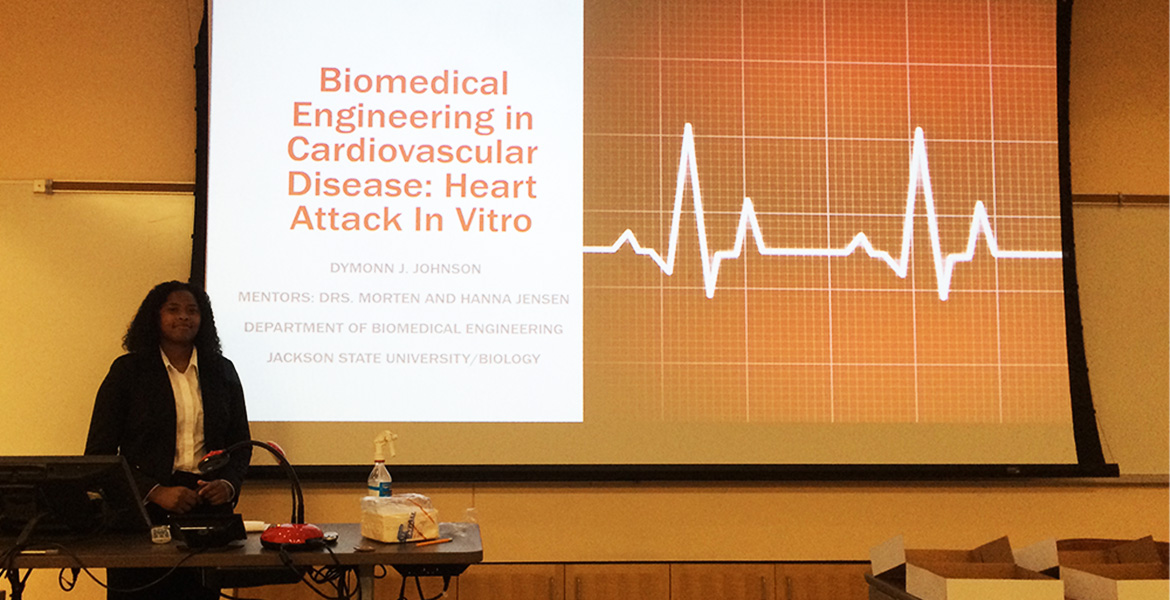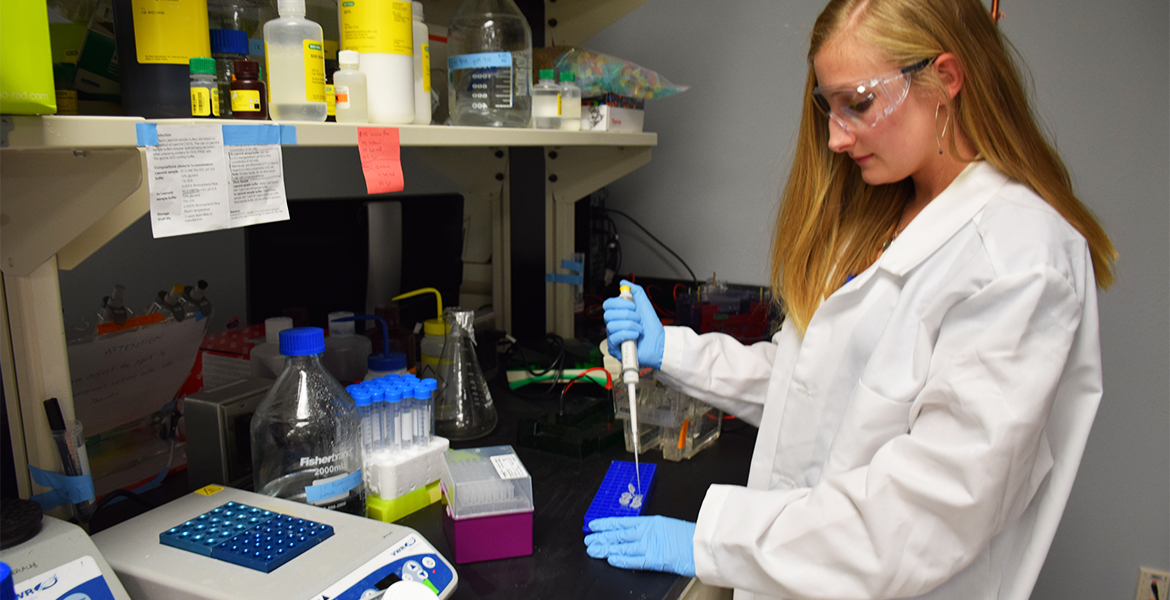Apr 24, 2017 | Questions & Answers

Khang in the lab
Alex Khang graduated in 2016 with an honors degree in biomedical engineering from the University of Arkansas. He is presently a PhD student in biomedical engineering at the University of Texas at Austin, and was recently awarded a National Science Foundation Graduate Research Fellowship for the upcoming academic year.
UArk BME: When you first arrived at the U of A, did you know what you wanted to study?
Khang: I did not know exactly what I wanted to study but I knew that math and science were my strongest areas so I considered majoring in an engineering discipline. Biomedical Engineering stood out to me amongst the rest of the engineering majors at the University of Arkansas due to its dedication to bettering the state of human health.
(more…)
Aug 19, 2016 | Questions & Answers

Johnson delivers a presentation on her summer research.
Dymonn Johnson is a Jackson State University student studying biology who originally hails from East Saint Louis, Illinois. This past summer, she worked in the labs of Drs. Morten and Hanna Jensen along with U of A graduate students, undergrads, and several Brazilian students participating in the Summer Research Internship program. Below, she answers questions on the nature, scope, and challenges of her summer research, and shares how her goals have shifted moving forward.
UArk BME: What were the goals of your research project?
Johnson: The research goals this summer were to cell culture cardiomyocytes, heart muscle cells, and to create a cardiac cell culture. After I am gone, the cardiomyocytes will be placed inside the cardiac cell culture and ischemia will be induced at will, which means to create a heart attack in vitro.
(more…)
Mar 14, 2016 | Questions & Answers

Greening in the Translational Biophotonics & Imaging Lab.
Gage Greening is a PhD student in the Biomedical Engineering Department at the University of Arkansas. He is part of the research team in Dr. Timothy Muldoon‘s Translational Biophotonics & Imaging Lab.
UArk BME: You mentioned in a 2014 piece in A+, the Honors College magazine, that you’ve, “always had a diverse set of interests, including the life sciences, math, athletics, and art, especially sketching and filmmaking.” How does being a biomedical engineer allow you to tap into some of these passions?
Greening: I think biomedical engineers need to have a diverse set of interests and skills to be successful. Biomedical engineering requires a combination of skills to think about medical problems in new ways. An understanding of life science is vital to knowing which problems are worth spending time to solve. Art and sketching are important for visually communicating with your colleagues through engineering sketches. In the design phase, design sketches are an engineer’s best friend. Math, logic, engineering, programming, and troubleshooting all come into play in my research. Seeing your finished project and presenting this project through conferences, presentations, or publications is tremendously satisfying because of all the hard work that goes into it. The many phases of a biomedical engineering research project encompass many of my passions, and that’s why I love going to work each day.
(more…)
Feb 17, 2016 | Questions & Answers

Ederle in the Mechanobiology & Soft Materials Lab.
Amanda Ederle is a student in the Biomedical Engineering Department at the University of Arkansas. She works under Dr. Kartik Balachandran in the Mechanobiology & Soft Materials Laboratory, and was recently awarded a SURF grant to continue her research work.
UArk BME: When you first arrived at the U. of A. as an Honors College Fellow, did you know what you wanted to study?
Ederle: I am actually a Public Health major, but I am doing biomedical engineering research for my Honors Thesis. I think my situation exhibits one of the great aspects of the Honors College. I can explore my diverse interests and incorporate all of them into my undergraduate education. I was originally drawn to public health because I was interested in exploring the broad perspective of medicine and health. I think that it is important for me to study public health because of the new focus on prevention techniques in the clinical medicine world; as a future physician, my public health background will provide me with the tools to examine health from a holistic perspective, originating as much from social aspects as genetic ones. However, though I love my public health courses, I found that I missed certain aspects of the sciences. I began to look at the research in the hard sciences on the U. of A.’s website, and Dr. Balachandran’s research really stood out to me. I reached out to Dr. B to express my interest, and the rest is history!
(more…)
Jan 25, 2016 | Questions & Answers

Hunter in the Translational Biophotonics & Imaging Lab.
Courtney Hunter is a student in the Biomedical Engineering Department at the University of Arkansas. She works under Dr. Timothy Muldoon at the Translational Biophotonics & Imaging Lab, and was recently awarded a SURF grant to continue her research work.
UArk BME: Did you come to the U. of A. knowing you wanted to study engineering?
Hunter: I actually came to the U. of A. with the intention of getting a degree in biology through the Fulbright College of Arts & Sciences. That had been my plan since I was a freshman in high school. I knew after I started my freshman year that biology was not the major for me; however, I did not know what else was out there. I met someone in my Cell Biology class during the spring of my freshman year (2014) who told me that he was a biomedical engineering major. That immediately sparked my interest. I had never considered engineering before, and I definitely did not know biomedical engineering was even an option. I did some online research and studied the course guide. The more and more I looked into it, the more I realized this was something I really wanted to do. I discussed it with my parents, and they were open to whatever I wanted to do. As I was finishing my freshman year, I changed my major to biomedical engineering, and I have never looked back. Kinan Alhallak, the student who introduced me to the major in the first place, is now a fellow researcher, classmate and a good friend.
(more…)
Jan 15, 2016 | Questions & Answers

Dr. Muldoon in the Translational Biophotonics & Imaging Lab.
Dr. Timothy Muldoon is an Assistant Professor in the Biomedical Engineering Department at the University of Arkansas. He is also the Principal Investigator of the University’s Translational Biophotonics & Imaging Lab.
UArk BME: Did you always know you wanted to pursue Biomedical Engineering? What attracted you to the discipline?
Muldoon: Yes, actually, since I was in high school I had thought about Biomedical Engineering. I was always interested in the application of mathematics and physics to engineering problems, and the humanitarian aspects of Biomedical Engineering specifically were attractive to me. It’s a dynamic and active research field that is both technically interesting and has great potential to significantly impact peoples’ lives.
(more…)






